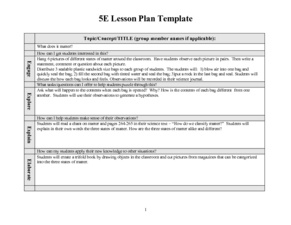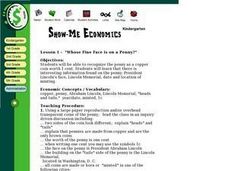Curated OER
Deciphering Community
Students explore the concept of a community. They identify and group various kinds of communities. Students create a concept map exemplifying their membership in different communities. They write a narrative describing their...
Curated OER
Defining Agriculture and Natural Resources
Students define agricultural using concept maps. In this agriculture lesson plan, students use concept maps to determine the ideas that are related to agriculture such as farming, food, flowers, and forestry before defining the word...
Curated OER
Frontline Muslims: Pre-Viewing Vocabulary Activity
Students become acquainted with vocabulary related to Islam and Muslim history in the film Frontline: Muslims. Students will work with the vocabulary from the film by categorizing the names and terminology, then work with the definitions...
Curated OER
Defining Character Traits
Students read and analyze an extended definition in preparation for writing an extended definition of a CHARACTER TRAIT. They use analogy as a definition strategy to tailor writing to a particular audience. Finally, students SHARE...
Curated OER
Discipline vs. Self-Discipline
Students explore self-discipline. In this character education instructional activity, students define and give examples of discipline and self-discipline. Students work with a group to complete a related concept map.
Curated OER
What Does It Matter?
Students match definitions with vocabulary words and learn basic facts about matter. Then, they see how to determine the physical characteristics of matter. They determine the mass, volume, and density of objects using appropriate tools...
Curated OER
Weather and Climate Around the World
Learners explain the difference between climate and weather. They gain concepts of currents and discuss how the currents have an affect on climate and weather. Students gain knowledge of the instruments that meteorologists use to predict...
Curated OER
What's in the Air?
In this air instructional activity, students will choose the correct definition for atmosphere, troposphere, stratosphere, and pollutant. Then students will complete a concept map showing what components make up air. This instructional...
Curated OER
Ocean Water and Life
In this ocean water and life learning exercise, students match the vocabulary term with the correct definition. Also, students answer questions by deciding if the statements are true or false. Finally, students complete concepts maps...
Curated OER
California Biodiversity
Students examine several maps of California exhibiting features such as precipitation, topography, and vegetation. They look for patterns that might be the source of or influence biodiversity in different regions. They pay particular...
Curated OER
Everyday Heroes
Students view a video on September 11, they discuss their emotions and reactions after viewing the tape. They discuss and analyze the different definitions of a hero in the context of September 11 and their own lives. Students write...
Curated OER
Inferring Themes
Fifth graders practice making inferences on various types of reading material. As a class, they develop a definition of the word "theme" and discuss themes for some of their favorite stories. They use the context of the reading...
Curated OER
What Does It Matter?
Learners define matter, the chemical properties of matter, and the physical properties of matter. They name physical and chemical properties of matter (by classifying using a Tree Map). Students determine the mass, volume, and density of...
Curated OER
Doing Our Share Lesson 1: Michigan History of Philanthropy
Students research the history of philanthropy in Michigan by looking at images and pictures while discussing the definition of philanthropy. They design a picture of the first time they saw a philanthropic act and write three sentences...
Curated OER
Show-Me Economics
Third graders distinguish between savings and spending. Students graph out a variety of important Economic concepts/vocabulary. They set up an imaginary job to save money and spend money.
Curated OER
Bioregions of California
Young scholars map out the bioregions of California by examining the species and environment in different areas of the state. They use information and pictures from a PowerPoint presentation to complete a map handout and play a trivia...
Curated OER
Atom and Eve
Learners research and define an atom using a concept map. They design and create a model of an atom, labelling all the parts, and write a journal entry.
Curated OER
What's Goin' Down?
Young scholars explore the concept of environmental stewardship. In this service learning instructional activity, students investigate the locations of the world's rain forests and concerns regarding the world's rain forests.
Curated OER
Life Is a Journey
Students consider the literal and figurative definitions of the word journey. In this metaphor lesson, students discuss life journeys and their diversity.
Curated OER
Identifying Reasons for World Trade
Students examine the advantages and disadvantages of world trade. They participate in a class discussion of international trade, read a handout about a specific country, and in small groups label a map with agricultural commodity...
Curated OER
Watercolor Ways
Students investigate the concept of being part of a global community. In this global community lesson, students learning the definition of stewardship as it relates to taking care of the Earth. They listen to the lyrics of the song,...
Curated OER
REPRODUCTION
Students complete a variety of activities to study different concepts in Science. The activities are part of a layered curriculum. This is used to differentiate instruction and give a wide variety of assessment opportunities.
Curated OER
Meteorology
Fourth graders study how atmospheric conditions change while naming the things that make the weather change. They investigate the affects of air masses, weather fronts and high/low pressure by looking at weather maps from newspapers.
Curated OER
Finding Area
Fourth graders explore how to find the area of a rectangular object. As a class, they discuss definition of area and strategies for finding area. The teacher models finding the area of an object by counting squares. Students observe...

























